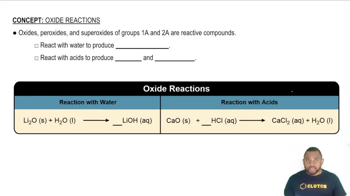Here are the essential concepts you must grasp in order to answer the question correctly.
Net Ionic Equations
A net ionic equation represents the chemical species that are involved in a reaction, excluding spectator ions. It highlights the actual chemical change occurring in a solution, focusing on the ions and molecules that participate directly in the reaction. This simplification is crucial for understanding the underlying chemistry, especially in aqueous reactions.
Recommended video:
Oxides and Their Reactions with Water
Oxides are compounds formed by the reaction of an element with oxygen. When certain oxides react with water, they can form either acids or bases, depending on their nature. For example, metal oxides typically produce basic solutions, while non-metal oxides often yield acidic solutions, which is essential for predicting the products of the reactions in the question.
Recommended video:
Balancing Chemical Equations
Balancing chemical equations is the process of ensuring that the number of atoms for each element is the same on both sides of the equation. This is based on the law of conservation of mass, which states that matter cannot be created or destroyed in a chemical reaction. Proper balancing is crucial for accurately representing the stoichiometry of the reaction and for deriving the correct net ionic equation.
Recommended video:
Balancing Chemical Equations
 Verified step by step guidance
Verified step by step guidance

